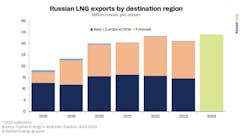Stock market and oil prices fell Dec. 8, with crude closing below $99/bbl in New York, as pessimistic markets shrugged off interest rates reductions by the European Central Bank (ECB) and a US government report of the lowest number of initial claims for unemployment benefits in 9 months.
However, natural gas rallied after the Energy Information Administration reported the withdrawal of 20 bcf from US underground storage during the week ended Dec. 2. That left 3.83 tcf of working gas in storage, up 102 bcf from a year ago and 307 bcf above the 5-year average.
Adam Sieminski, chief energy economist, Deutsche Bank AG, Washington, DC, said, “Despite a warm start to the heating season, the probability for the current La Nina event to continue through early spring (March-April) is higher than 50% according to forecasters at National Oceanic and Atmospheric Administration. This would introduce the potential of a more rapid storage drawdown this winter.”
Stock indexes turned around in early trading Dec. 9 after all 17 members of the Euro-zone agreed to a treaty that will provide more central authority over their individual budgets in response to the growing debt crisis in Europe. Another nine members of the European Union are considering signing the treaty that was hammered out in an all-night session. Only the UK turned it down.
Analysts remained skeptical of the latest European effort, however. “A pledge to regulate budgets is all well and good, but without a commitment from the ECB to print lots of euros, it doesn't address the immediate issue at hand,” said analysts in the Houston office of Raymond James & Associates Inc.
Despite their marathon overnight session, EU leaders failed to come up with a binding pact for all 27 nations represented and resorted instead “to intergovernmental treaties,” said Olivier Jakob at Petromatrix in Zug, Switzerland. “The text of the agreement is to be finalized by March, and after that we will still have to go through the ratification process for those countries that want to join in.”
Meanwhile, everyone is waiting to see if Standard & Poor’s follows through on its threat to downgrade credit ratings of 15 Euro-zone countries, including the strongest European economies of Germany and France, pending the outcome of the Dec. 9 summit (OGJ Online, Dec. 6, 2011).
“Given the poor political unity between the EU-27 members, we have to increase the risk assessment that the next step is to see some downgrade review materialize maybe even before the end of the year,” said Jakob. “[Although] the Italian 10-year bond yields were falling sharply at the beginning of the week, they are now surging back towards their previous peaks. The Italian-to-German bond spread is back over 5%, and the Italian 10-year bonds back above the 7% mark. Not good.”
Jakob said, “For weeks, global assets have been supported by all sorts of rumors that the ECB will become the buyer of last resort, but yesterday the head of the ECB poured some water on those hopes. The ECB will stick to its constitutional mandate and will not engage in any financial engineering scheme with the International Monetary Fund. The ECB did cut interest rates from 1.25% to 1%, but overall it did not come up with any [balm for the European economy].”
The European Banking Authority later increased its estimate of the European capital shortfall under the stress-test, “which will likely lead European banks to sell more assets by June,” said Jakob.
Sieminski said, “Commodity index returns remain positively correlated to the US equity market. The fact that the current episode of risk aversion is one of the longest in history as well as the tendency of the S&P 500 Index to rally in US presidential election years are encouraging signs for index returns heading into 2012, in our view. However, ultimately the performance of index returns will be determined by the extent to which a more pronounced downturn in economic activity can be averted.”
In other news, he said, “We believe China will add about 950,000 b/d of new refinery capacity over the course of 2012 and utilize it. This could add to the country's stockpiling requirements, which could mean that the 5.5% consensus for oil growth in China is too low.”
Energy prices
The January contract for benchmark US light, sweet crudes continued to fall, down $2.15 to $98.34/bbl Dec. 8 on the New York Mercantile Exchange. The February contract dropped $2.14 to $98.54/bbl. On the US spot market, West Texas Intermediate at Cushing, Okla., was down $2.15 to $98.34/bbl.
Heating oil for January delivery lost 5.26¢ to $2.93/gal on NYMEX. Reformulated stock for oxygenate blending for the same month declined 2.03¢ to $2.57/gal.
The January natural gas contract regained 3.6¢ to $3.46/MMbtu on NYMEX. On the US spot market, gas at Henry Hub, La., gave back 1.1¢ to $3.43/MMbtu.
In London, the January IPE contract for North Sea Brent lost $1.42 to $108.11/bbl. Gas oil for December dropped $9 to $948.25/tonne.
The average price for the Organization of Petroleum Exporting Countries’ basket of 12 benchmark crudes was down $1.08 to $109.02/bbl.
Contact Sam Fletcher at [email protected].

